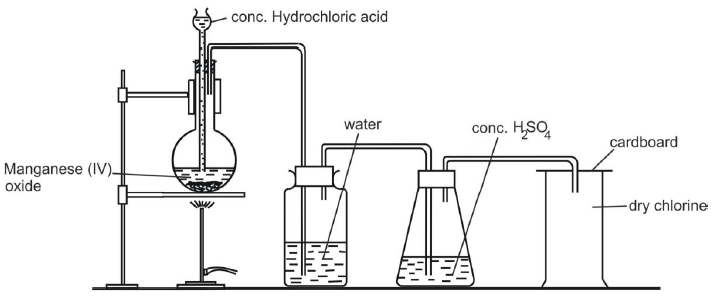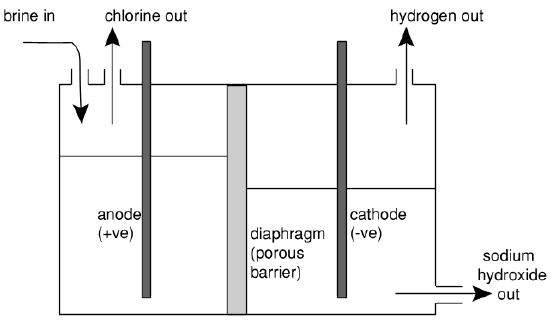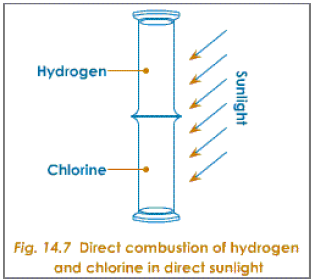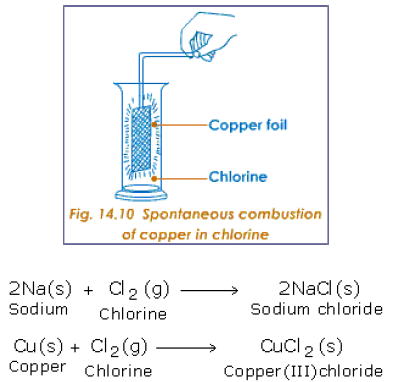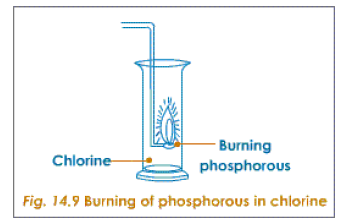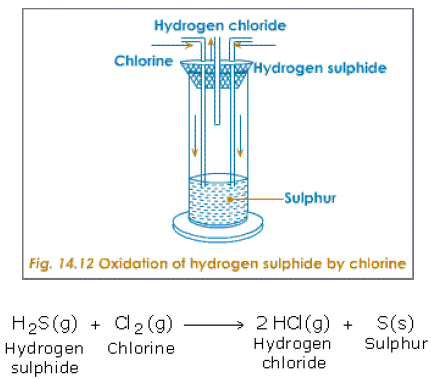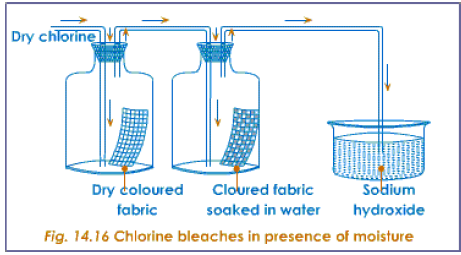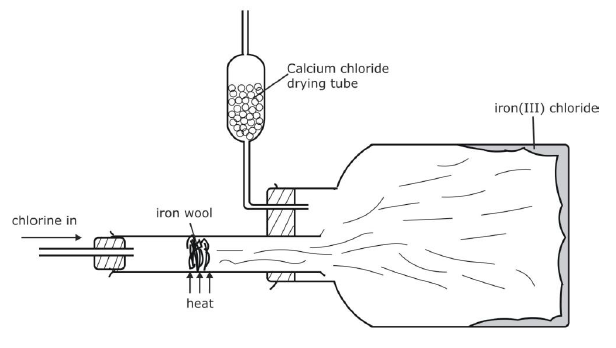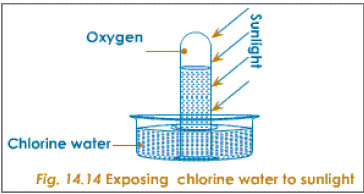
Chlorine
- Halogen is elements in group (vii) of the periodic table.
- Chlorine is a halogen as well as fluorine, bromine, iodine and astatine.
- Chlorine has a symbol 35.5Cl because it is made up of two isotopes 37 Cl and 35 Cl.
- It has an electronic arrangement of 2:8:7, hence justifying its position in group (vii).
Laboratory Preparation
- In order to convert hydrogen chloride to chlorine, it is necessary to remove hydrogen.
- Removal of hydrogen is oxidation.
- A powerful oxidizing agent such as manganese (IV) oxide converts hydrogen chloride (HCl) to chloride (Cl2)
- The most common laboratory method for preparation of Chlorine is to heat of Manganese Dioxide with concentrated Hydrochloric Acid.
- The gas is bubbled through water to remove any traces of hydrochloric gas that may be present and then it is dried by bubbling it through concentrated sulphuric acid.
- Chlorine may also be prepared by dropping cold concentrated Hydrochloric Acid on crystals of Potassium Permanganate.
2 KMnO4(aq) + 16HCl(aq) → 2MnCl2(s) + 2KCl(s) + 8H2O(l) + 5Cl2(g) - The gas is also bubbled through water to remove any traces of Hydrochloric Acid gas that may be present and then it is dried by bubbling it through concentrated Sulphuric Acid.
Manufacture of Chlorine
Membrane Cell
- Chlorine is manufactured industrially as a by-product in the manufacture of Caustic Soda by the electrolysis of brine.
2 NaCl(aq) + 2 H2O(l) → Cl2(g) + H2(g) + 2NaOH(aq) - The membrane cell has titanium anode and a nickel cathode.
- Titanium is chosen because it is not attacked by chlorine.
- The anode and the cathode compartments are separated by an ion exchange membrane.
- The membrane is selective; it allows Na+ ions, H+ and OH- ions to flow but not Cl- ions.
- These ions cannot flow backwards, so products are kept separate and cannot react with each other
- At anode, the Cl- ions are discharged more readily than OH- ions because they are in higher concentration and are hence preferred.
2 Cl-(aq) → Cl2(g) + 2e- - A pale green gas is seen coming off at the anode
At cathode, it is the H+ ions that accept electrons, as sodium is more reactive than hydrogen
2 H+(aq) + 2e- → H2(g) - Bubbles of hydrogen are seen at the cathode
- The remaining ions of Na+ and OH- join up and come off as sodium hydroxide, NaOH.
Products and Uses
| Product | Uses |
| Chlorine | Poisonous greenish yellow gas Used for making; PVC, solvents for dry cleaning, paints and dye stuffs, bleaches, weed killers, pesticides, killing bacteria in swimming pools and in domestic water treatment. |
| Hydrogen | Colourless flammable gas Used for making: Margarine, nylon, hydrochloric acid |
| Sodium Hydroxide |
Alkaline and corrosive substance |
Properties of Chlorine
Test for Chlorine Gas, Cl2(g).
- Will turn moist litmus or universal indicator paper red, and then bleach it white.
- Is green-yellow in colour.
- Has a pungent choking smell and is poisonous. It is twice as dense as air.
- Will put out a lit splint.
Collecting Chlorine
- Chlorine is denser than air and can be collected by downward delivery or using a gas syringe.
Reactions
- Chlorine is a highly reactive element, and undergoes reaction with a wide variety of other elements and compounds.
- Chlorine is a good bleaching agent, due to its oxidising properties.
- Chlorine is soluble in water (which solution is called Chlorine Water) and this loses its yellow colour on standing in sunlight, due to the formation of a mixture of Hypochlorous Acid and Hydrochloric Acid.
Cl2(g) + H2O(l) → HOCl(aq) + HCl(aq) - Chlorine gas supports the vigorous combustion of many elements to form their chlorides. For example, Sulphur and Phosphorus burn in the gas.
Cl2(g) + S(s) → SCl2(s)
Cl2(g) + P(s) → PCl3(s) + PCl5(s)
Bleaching Action
- If chlorine is passed through water, it forms two acids, hydrochloric acid.
Cl2(g) + H2O(l) ⇌ HCl(aq) + HOCl(aq) - Hypochlorous acid (the second acid) is the source of oxygen and is responsible for the bleaching of chlorine.
HClO(aq) + Dye(coloured) →HCl(aq) + oxidized Dye(colourless) - It is important to wash bleached clothes thoroughly to remove hydrochloric acid formed after the process.
Reaction of Chlorine with Hydrogen
- A mixture of Chlorine and Hydrogen explodes when exposed to sunlight to give Hydrogen Chloride.
- In the dark, no reaction occurs, so activation of the reaction by light energy is required.
- Hydrogen and chlorine gas also combine directly in presence of sunlight.
- A jar of hydrogen is inverted and placed on a jar containing chlorine in the sun. Soon hydrogen chloride is formed
- In diffused sunlight, the reaction slows down, and in the dark it is very slow.
Cl2(g) + H2(g) → 2 HCl(g) - Hydrogen chloride is highly soluble in water. It dissolves to form hydrochloric acid. This reaction can be used to produce hydrochloric when the hydrogen chloride gas produced is dissolved in water as shown.
Reaction of Chlorine with Non-Metals
- Chlorine combines directly with most non-metals (except with Nitrogen, Oxygen and Carbon, C).
Reaction of Chlorine with Metals
- Thin foils of metals like sodium, copper, etc. when plunged into a jar of chlorine gas catch fire spontaneously to form their respective chlorides.
With Yellow Phosphorous
- Yellow phosphorus first melts and then catches fire spontaneously when introduced into a jar of chlorine gas.
- It forms thick white fumes of phosphorus (III) chloride and phosphorus (V) chloride
Reaction with hydrogen sulphide
- On passing chlorine and hydrogen sulphide through separate vents in a upright combustion tube hydrogen sulphide gets oxidised to hydrogen chloride and sulphur .
- Hydrogen chloride comes out through the middle tube.
- If chlorine is passed through a solution of hydrogen sulphide in water the solution turns turbid due to the formation of free sulphur.
Reaction with aqueous sodium sulphite
- When chlorine is passed through an aqueous solution of sodium sulphite it gets converted to sodium sulphate.
- Chlorine first reacts with the water to form nascent oxygen.
- The nascent oxygen then gets added to the sodium sulphite to form sodium sulphate.
- The overall reaction can be written as:
Displacement of the Halogens by Chlorine
- Halogens are the most electronegative elements.
- Fluorine is the most electronegative, followed by chlorine then bromine and then iodine.
- The relative reactivity of the halogens, as described in group trends, can be shown by displacement reactions.
- These are similar to the metal displacement reactions.
- For example, Bromine gas bubbled through a solution of potassium iodide in water will displace (take the place of) the less reactive iodine, forming iodine and potassium bromide.
Bromine + potassium iodide → potassium bromide + iodine.
Br2(g) + 2KI(aq) → 2KBr(aq) + I2(s) - Similarly, chlorine will displace less reactive halogens. Chlorine will displace both bromine and iodine from the appropriate salt. This can be used in the extraction of bromine from sea water.
Chlorine + potassium iodide → potassium chloride + iodine.
Cl2(g) + 2KI(aq) 2KCl(aq) + I2(s) - The equations can be written in terms of ions (called ionic equations).For example, the last equation can be written as
Cl2(g) + 2I-(aq) → 2Cl-(aq) + I2(s) - Potassium iodide, on the left, exists as potassium ions (K+) and iodide ions (I-) and potassium chloride, on the right, exists as potassium ions (K+) and chloride ions (Cl-).
- Potassium ions (or other metal ions) can be left out of the ionic equation because they do not take part in the reaction.
- They are called 'spectator ions', as though they just sit back and watch!
- Fluorine being the most electronegative halogen can displace all the other elements of this group (chlorine, bromine and iodine) from the aqueous solution of their salts.
- Chlorine can displace bromine and iodine from bromides and iodides respectively. However, it cannot displace fluorine from fluorides.
- Bromine can displace iodine from iodides. But it cannot displace chlorine or fluorine from chlorides or fluorides respectively.
- Iodine being the least electronegative of the halogens cannot displace any other halogen from their respective halides.
Summary of Displacement Reactions
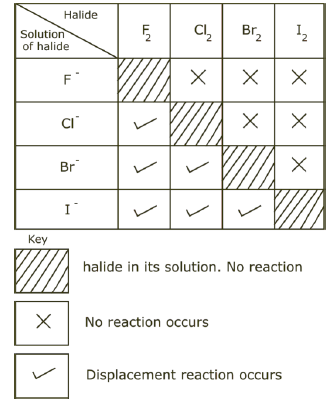
Bleaching Action of Chlorine
- Chlorine bleaches (removes the color) organic colors by the process of oxidation in presence of moisture. The bleaching action takes place in few step
- Chlorine first dissolves in water to give a mixture of hydrochloric acid and hypochlorous acid.
- As mentioned earlier hypochlorous acid is very unstable and decomposes to give hydrochloric acid and nascent oxygen.
- The nascent oxygen oxidises the coloring matter to colorless matter thereby bleaching them.
Coloring matter + Nascent oxygen → Colorless matter
- Chlorine first dissolves in water to give a mixture of hydrochloric acid and hypochlorous acid.
- leaching by chlorine is permanent. Chlorine bleaches cotton fabrics, wood pulp litmus etc. However, it is not used to bleach delicate articles such as silk, wool etc., as it is a strong bleaching and oxidizing agent. This dual action will damage the base material.
- You must have noticed that in the very first stage, presence of water is essential to produce hypochlorous acid.
- The dry coloured fabric does not bleach. The coloured fabric soaked in water is bleached. This shows that chlorine only bleaches in the presence of water. If water is absent no bleaching can take place. Dry chlorine therefore does not bleach.
Tests for Chlorine
- Chlorine is a greenish yellow gas with a pungent and irritating odour.
- It turns wet blue litmus paper red and then bleaches it.
- Colored petals and the leaves of plants can be bleached by it.
- Chlorine turns wet starch potassium iodide paper blue by displacing the iodine from the potassium iodide, and causing iodine to turn the starch blue.
Oxidizing Reaction of Chlorine
- Chlorine is a strong oxidising agent. Chlorine oxidises Iron (II) Chloride, FeCl2, to the salt containing Iron in the higher oxidation state Iron (III) Chloride, FeCl3. This is possible because Iron has a variable valency.
2 FeCl2(s) + Cl2(g) → 2 FeCl3(s) - Chlorine displaces the less electronegative Bromine and Iodine from their respective salts.
Cl2(g) + 2 KBr(s) → 2KCl(s) + Br2(s)
Chlorine removes Hydrogen from the hydrides of non-metals, forming Hydrogen Chloride, and leaving the non-metal element.
Cl2(g) + H2S(g) → 2HCl(g) + S(s)
Affinity for Hydrogen
- Chlorine combines with free hydrogen to form hydrogen chloride. It can also react with the hydrogen present in other compounds such as water, ammonia, hydrocarbon, hydrogen sulphide etc.
Reaction with Water
- Chlorine dissolves in water to form chlorine water. It slowly reacts with the water to form a mixture of hydrochloric acid and hypochlorous acid.
- Hypochlorous acid is very unstable and in presence of sunlight it decomposes to give hydrochloric acid and a nascent oxygen atom.
- Two such nascent oxygen atoms combine to form a molecule of oxygen.
[O] + [O] → O2(g) - So if a solution of chlorine in water is exposed to sunlight as shown in figure 14.14, oxygen is formed.
Reaction with ammonia
- Depending on which of the two gases is in excess, chlorine reacts with ammonia in two ways.
- When ammonia is in excess the final products are ammonium chloride and nitrogen.
Hydrogen chloride thus produced reacts with excess of ammonia to produce ammonium chloride.
The overall reaction can be written as: - When chlorine is in excess the final product is an oily explosive liquid called nitrogen trichloride.
- When ammonia is in excess the final products are ammonium chloride and nitrogen.
Reaction with Alkalis
- Alkalis, at different temperatures and at different levels of concentration, behave differently with chlorine.
- With cold dilute alkalis
Chlorine reacts with cold dilute alkalis to form their respective chlorides, hypochlorites and water. - With hot concentrated alkalis
Chlorine reacts with hot concentrated alkalis to form their respective chlorides, chlorates and water.
- With cold dilute alkalis
Uses of Chlorine
- Chlorine is used
- For the manufacture of bleaching powder and liquid bleaches,
- To bleach fabrics (e.g. linen and cotton), wood pulp and paper,
- For the direct manufacture of Hydrochloric Acid by the direct combination of its elements,
H2(g) + Cl2(g) → 2HCl(g) - In the manufacture Sodium Hypochlorite (i.e. domestic bleach), disinfectants, insecticides, plastics and Hydrochloric Acid,
- As a disinfectant used to kill bacteria in the preparation of drinking water.
- Chlorine is also important in the manufacture of paints, aerosol propellants and plastics.
- Also used to make some explosives, poison gases and pesticides.

Hydrogen Chloride
- Hydrogen chloride is an hydrogen compound of Chlorine
- Chlorine is a highly reactive element and is mainly found in combined state.
- Its most important source is sodium chloride which is mainly found in large underground deposits, sea and lake such as lake Magadi.
- Sodium chloride is the main source of chlorine which is used to make hydrogen chloride.
Preparation of Hydrogen Chloride
- Hydrogen Chloride may be prepared in the laboratory by heating Concentrated Sulphuric Acid, with Sodium Chloride.
NaCl(s) + H2SO4(aq) → NaHSO4(s) + HCl(aq)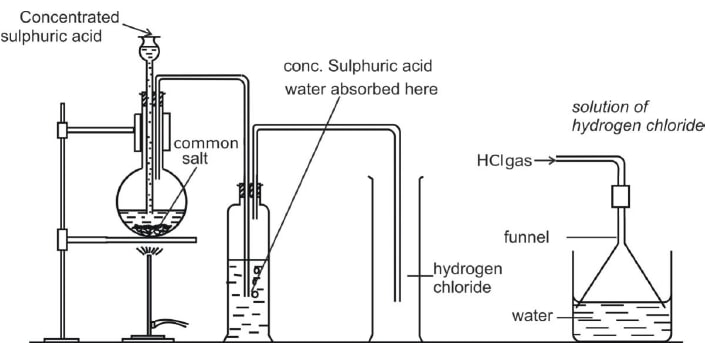
Preparing and Making a Solution of Hydrogen Chloride
- It is prepared industrially by the combustion of Hydrogen, H2, in Chlorine, Cl2.
H2(g) + Cl2(g) → 2HCl(g)
Other way of producing chlorine
- Chlorine, removes Hydrogen, from the hydrides of non-metals, forming Hydrogen Chloride, and leaving the non-metal element.
Cl2(g) + H2S(g) → 2HCl(g) + S(s) - When Chlorine Water, (i.e. a solution of Chlorine gas, in Water) in a flask inverted in a basin of the same liquid is exposed to bright sunlight, the Chlorine is decomposed and a solution of Hypochlorous Acid remains.
H2O(l) + Cl2(s) → HCl(aq) + HClO(aq) - The Hypochlorous Acid, is not very stable and the solution readily decomposes, especially when exposed to sunlight, yielding Oxygen,
2HClO(aq) → 2HCl(aq) + O2(g) - Chlorine is soluble in water (which solution is called Chlorine Water) and this loses its yellow colour on standing in sunlight, due to the formation of a mixture of Hypochlorous Acid, and Hydrochloric Acid.
Cl2(g) + H2O(l) → HOCl(aq) + HCl(aq)
Properties of Hydrogen Chloride
Hydrogen Chloride in Solution
- Hydrogen chloride is a colourless fuming gas.
- The polar covalent gas Hydrogen Chloride is very soluble in Water.
- In aqueous solution, the molecule exists in ionic form, as the positively charged Hydrogen Ion, H+, and the negatively charged Chloride Ion, Cl-.
HCl+(aq) → H+(aq) + Cl-(aq) - Its solution in water turns blue litmus paper red. Hydrogen chloride has no effect on dry litmus paper as no ions are present in dry gas.
The Importance of Water
- The gas hydrogen chloride is made up of covalently bonded molecules. If the gas is dissolved in an organic solvent, such as methylbenzene, it does not show any of the properties of an acid.
Dissolving hydrogen chloride in water and methylbenzene
| Test | Observation with hydrogen chloride dissolved in water | Observation with hydrogen chloride dissolved in methylbenzene |
| Temperature change when the solution is made | Marked temperature rise | Very slight temperatures change |
| Effect on dry litmus paper | Turns red | Little or no change |
| Reaction with magnesium ribbon | Hydrogen gas evolved rapidly | No reaction |
| Reaction with calcium carbonate | Carbon dioxide given off rapidly | No reaction |
| Electrical conductivity | Conducts electricity and hydrogen is evolved at the cathode | Non-conductor |
- For example, it does not conduct electricity or turn a piece of blue litmus paper red.
- However, when the gas is dissolved in water, a strongly acidic solution is produced. The acidic oxides of sulphur, phosphorus and carbon are the similar.
- They are covalent molecules when pure, but show acidic properties only when dissolved in water.
Reaction with Group 1 Alkali Metals
- Alkali metals burn very exothermically and vigorously when heated in chlorine to form colourless crystalline ionic salts e.g. NaCl or Na+Cl-.
- This is a very expensive way to make salt! It’s much cheaper to produce it by evaporating sea water!
E.g. sodium + chlorine → sodium chloride
2Na(s) + Cl2(g) → 2NaCl(s) - The sodium chloride is soluble in water to give a neutral solution pH 7, universal indicator is green.
- The salt is a typical ionic compound i.e. a brittle solid with a high melting point.
- Similarly potassium and bromine form potassium bromide KBr, or lithium and iodine form lithium iodide LiI. Again note the group formula pattern.
- Hydrochloric acid reacts with metals above hydrogen in the reactivity series. All of these metals react with hydrochloric acid liberating hydrogen which puts out a burning splint with a pop sound.
Zn(s) + 2HCl(aq) → ZnCl2(aq) + H2(g) - This is a common reaction for preparing hydrogen gas in the school laboratory.
- The hydrogen can then be collected over water.
- The salts produced can be obtained from the solution by filtration to obtain the filtrate which then transferred onto an evaporation dish for evaporation and crystallization.
- No hydrogen is liberated when the acid is reacted with lead, copper and mercury.
- Despite the fact that lead is above hydrogen in the reactivity series, the hydrogen chloride is not a strong enough oxidizing agent to liberate hydrogen.
Reaction with Bases
- Hydrochloric acid is a strong acid as it is well ionized in solution. It neutralizes bases and alkalis forming salts and water.
KOH(aq) + HCl(aq) → KCl(aq) + H2O(l)
CuO(s) + HCl(aq) → CuCl2 (aq) + H2O(l)
FeO(s) + 2 HCl(aq) → FeCl2(aq) + H2O(l)
Reaction with Carbonates
- Hydrogen chloride reacts with carbonates and hydrogen carbonates producing carbon dioxide, salt and water.
- Carbon dioxide turns lime water milky.
CaCO3(aq) + 2HCl(aq) → CaCl2(aq) + CO2 (g)+H2O(l)
Ionic equation
CO32-(aq) + 2H+(aq) → CO2(g) + H2O(l) - NaHCO3(aq) + HCl(aq) → NaCl(aq) + CO2(aq) + H2O(l)
Ionic equation
HCO3-(aq) + H+(aq) → CO2(g) + H2O(l)
Reaction with hydrogen H2
- Halogens readily combine with hydrogen to form the hydrogen halides which are colourless gaseous covalent molecules.
E.g. hydrogen + chlorine → hydrogen chloride
H2(g) + Cl2(g) → 2HCl(g) - The hydrogen halides dissolve in water to form very strong acids with solutions of pH1 e.g. hydrogen chloride forms hydrochloric acid in water HCl(aq) or H+Cl-(aq) because they are fully ionised in aqueous solution even though the original hydrogen halides were covalent.
- An acid is a substance that forms H+ ions in water.
- Bromine forms hydrogen bromide gas HBr(g), which dissolved in water forms hydrobromic acid HBr(aq).
- Iodine forms hydrogen iodide gas HI(g), which dissolved in water forms hydriodic acid HI(aq). Note the group formula pattern.
Oxidation of hydrochloric acid
- The most common laboratory method for preparation of Chlorine is to heat Manganese Dioxide, with concentrated Hydrochloric Acid.
MnO2(s) + 4 HCl(aq) → MnCl2(s) + 2 H2O(l) + Cl2(g) - The gas is bubbled through water to remove any traces of hydrochloric gas that may be present and then it is dried by bubbling it through concentrated sulphuric acid.
- Chlorine may also be prepared by dropping cold concentrated Hydrochloric Acid, on Potassium Permanganate.
2KMnO4(s) + 16HCl(l) → 2MnCl2(s) + 2KCl(s) + 8H2O(l) + 5Cl2(g)
Summary of Properties of Hydrogen Chloride
Physical Properties
| Color | Colourless |
| Odour | Pungent Odour Poisonous |
| Density(heavier or lighter than air) | Heavier than air |
Chemical Properties
| Solubility in water | Very soluble in water. It reacts with water to form hydrochloric acid |
| Burning | does not support combustion |
| Moist pH paper | acidic reaction |
| Red rose petals | no reaction |
| Specific test | it will fume in moist air |
Join our whatsapp group for latest updates
Tap Here to Download for 50/-
Get on WhatsApp for 50/-
Download CHLORINE AND ITS COMPOUNDS - Chemistry Notes Form 3.
Tap Here to Download for 50/-
Get on WhatsApp for 50/-
Why download?
- ✔ To read offline at any time.
- ✔ To Print at your convenience
- ✔ Share Easily with Friends / Students


